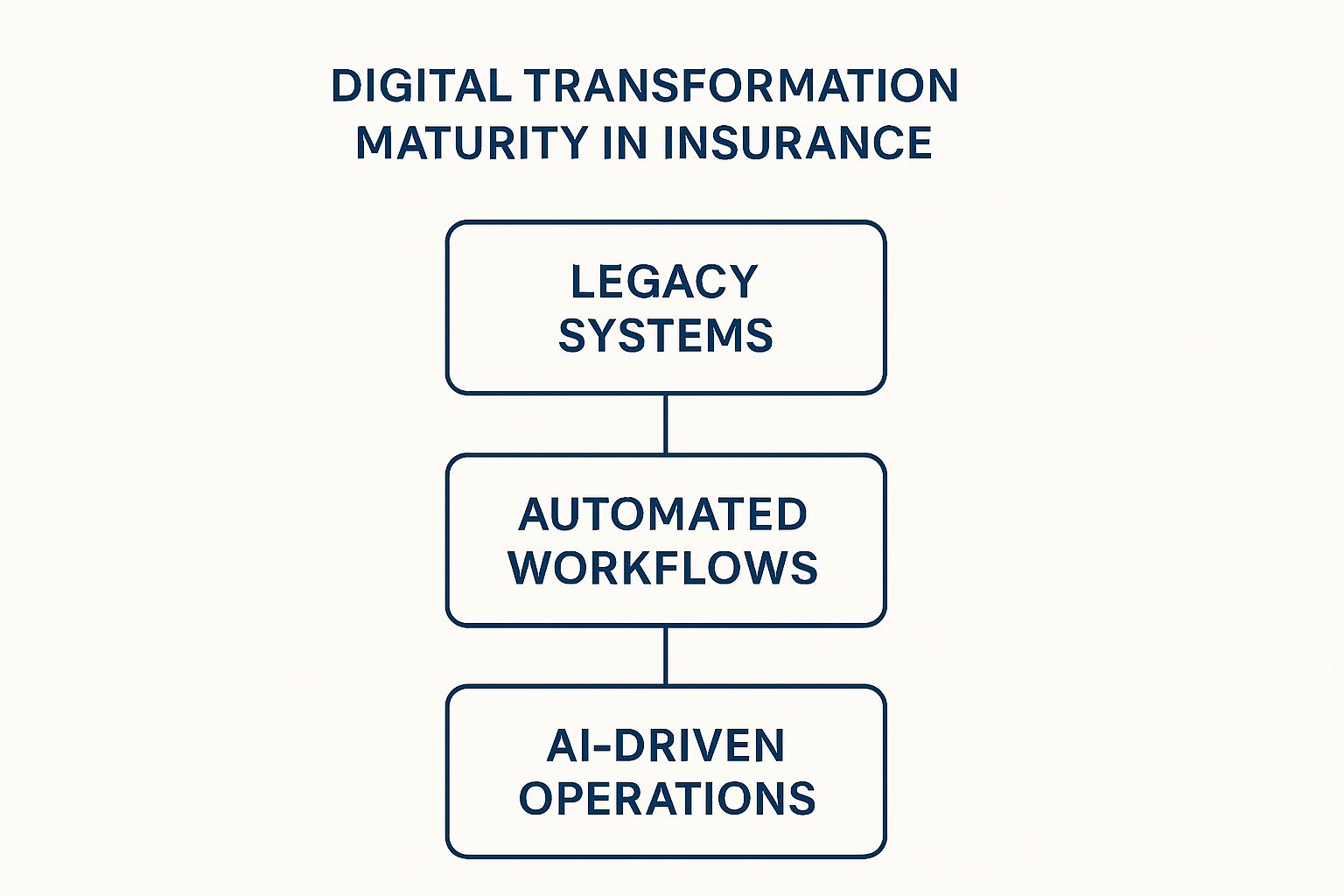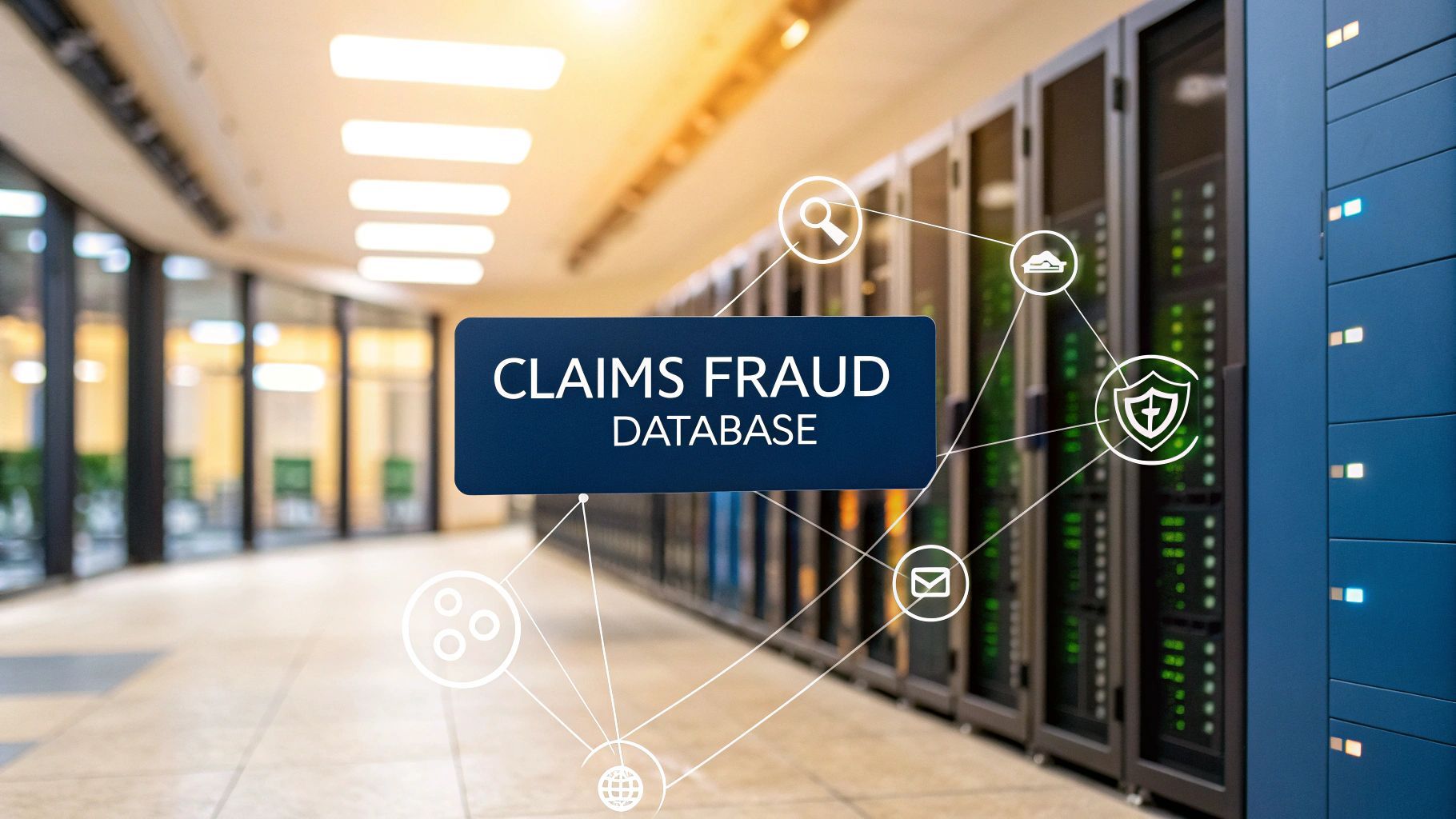Digital Transformation in the Insurance Industry: A UK Guide
For decades, the insurance industry felt stuck in the past. It was a sector built on mountains of paperwork, slow manual processes, and endless telephone calls. Digital transformation is about tearing down that old structure and replacing it with something smarter, faster, and driven by provable data.
It’s a fundamental rethink of how UK insurers operate, spurred on by two powerful forces: customers who expect seamless digital service, and the urgent need to tackle insurance fraud, which drives up costs for every single policyholder.
The Digital Shift Remaking UK Insurance

The UK insurance industry is finally moving away from its traditional, often cumbersome, foundations. This isn't just about bolting on a new piece of software; it's a complete reimagining of how insurers assess risk, communicate with policyholders, and—most importantly—verify claims.
Think of it like swapping an old, hand-drawn map for a real-time GPS. One gives you a rough idea, while the other provides instant, verifiable data to get you where you need to go without guesswork. This shift is essential for survival. Today's customers, used to the slick experience of online banking and retail, will not tolerate anything less from their insurer.
Responding to Customer Demand
People want to manage their policies, file claims, and get support through intuitive apps, not by waiting on hold or digging through filing cabinets. This isn't just a feeling; the numbers back it up.
A recent survey, for instance, revealed that around 90% of UK life insurance policyholders would rather manage their policies themselves online. It’s a clear signal that customers want control, convenience, and on-demand platforms.
This pressure from customers is forcing insurers to modernise or risk being left behind. The goal is to create an experience that is not only faster but also more transparent and empowering for the person paying the premium.
The Rising Threat of Insurance Fraud
Beyond customer expectations, there’s a much bigger financial driver pushing this transformation forward: the relentless fight against insurance fraud.
Fraud isn't a victimless crime. It's a systemic drain that forces insurers to raise premiums for honest customers to cover the losses from bogus claims. The Association of British Insurers (ABI) consistently reports that undetected general insurance fraud costs the industry billions each year—a cost that ultimately lands on every policyholder's bill.
Digital transformation gives the industry the tools to build a much stronger defence against fraudulent activity. By creating verifiable, transparent, and data-backed claims processes, technology shores up the integrity of the entire system.
This evolution is vital for building a more sustainable and trustworthy insurance ecosystem. To get a better sense of how these changes are playing out, you can explore the future of insurance trends to watch in 2025. By embracing these digital tools, the industry can finally start protecting itself—and its honest customers—from the massive financial drain of fraud.
The Technologies Powering a Smarter Industry
At the heart of this digital shift in insurance are several key technologies working in concert. This isn't about simply adopting one new piece of software; it's about building a digital toolkit that fundamentally changes how insurers operate—from pricing risk to validating claims.
These tools are the engine driving the industry from reactive, paper-based processes to a more proactive, evidence-led model. The end goal is to create a system that’s not just more efficient, but far more secure and fair for everyone involved.
AI and Machine Learning: The Digital Detectives
Artificial Intelligence (AI) and Machine Learning (ML) are the brains of the operation. Think of them as tireless digital detectives, capable of sifting through vast amounts of claims data to spot the subtle patterns of fraud that would be impossible for a human analyst to see.
For instance, an ML algorithm can analyse thousands of claims at once, flagging suspicious links between claimants, repair shops, and medical providers. It can also identify inconsistencies in claim narratives or evidence that hints at manipulation. This moves fraud detection from a manual, "needle-in-a-haystack" exercise to an automated, precise science.
While these tools are powerful, they must be used carefully to ensure fairness and accuracy. You can explore why AI in insurance is a double-edged sword and understand the importance of responsible implementation.
Data Analytics: For Fairer Premiums
If AI is the detective, then data analytics is the forensics laboratory. This technology allows insurers to move beyond broad, demographic-based risk pools towards highly personalised, fairer premiums. By analysing specific data points—like a driver's telematics data or a property's flood risk sensors—insurers can price policies based on actual, provable behaviour and circumstances.
This has a direct impact on costs for everyone. When risk is priced more accurately, responsible customers no longer subsidise high-risk ones. This data-driven approach fosters a more transparent relationship, where premiums directly reflect verifiable risk.
The push to adopt these technologies is gathering pace. In fact, a recent analysis shows that by 2025, over 63% of UK insurance executives will have invested in these capabilities, an adoption rate that outstrips the 50% seen in the US market.
Cloud Computing: The Engine Room
None of this would be possible without a flexible and powerful foundation. Cloud computing provides the essential infrastructure—the engine room—that powers this entire transformation. Legacy systems are often rigid, expensive to maintain, and simply cannot handle the sheer volume of data needed for modern analytics.
The cloud provides the necessary agility and scalability. It allows insurers to:
- Deploy new applications quickly without massive upfront hardware costs.
- Scale computing power up or down based on real-time demand, like a surge in claims after a major storm.
- Securely store and process vast datasets , providing the fuel for AI and analytics engines.
This infographic shows the journey insurers are on, moving from cumbersome, outdated systems to more sophisticated, AI-driven operations.

The diagram clearly shows a progression from rigid, legacy systems towards a future where operations are not just automated but intelligently guided by AI. Together, these technologies are building a more resilient, customer-focused, and fraud-resistant insurance industry.
Core Technologies in Insurance Transformation
To bring it all together, here’s a quick look at how these core technologies are being applied in the UK insurance sector, especially in the fight against fraud and unnecessary costs.
| Technology | Primary Application in Insurance | Impact on Fraud and Costs |
|---|---|---|
| AI & Machine Learning | Automating claims processing, detecting complex fraud patterns, and personalising customer interactions. | Significantly reduces fraudulent payouts by identifying suspicious activity humans might miss. |
| Data Analytics | Enabling dynamic, usage-based insurance (UBI) pricing and performing predictive risk modelling. | Creates fairer premiums, reducing the need for honest policyholders to subsidise high-risk ones. |
| Cloud Computing | Providing scalable infrastructure for data storage and processing, enabling rapid deployment of new services. | Lowers operational overheads by replacing costly legacy systems and improves data security. |
Ultimately, these tools create a system where claims can be verified with greater certainty, which reduces the costs that are eventually passed on to all policyholders.
Strengthening Claims Provability to Combat Fraud

It’s easy to think of insurance fraud as a victimless crime, a small bite out of a massive corporate apple. But that couldn’t be further from the truth. Every fraudulent claim paid is a cost that eventually trickles down to honest policyholders, pushing up premiums for everyone.
The scale of this problem is staggering. The Association of British Insurers (ABI) has found that undetected general insurance fraud costs the UK well over £1 billion every single year. That figure doesn't even touch on the organised ‘crash for cash’ schemes that continue to plague motor insurance. This isn't just an industry problem; it's a financial burden on every person with a policy.
Thankfully, the same digital shift that's improving customer service is also creating a powerful new standard for proving claims. We're moving away from a system built on paperwork and trust towards one grounded in verifiable, data-backed evidence.
Using AI to Uncover Hidden Connections
Artificial intelligence is now at the forefront of this fight. Think of it as a super-powered detective, capable of sifting through millions of data points from past and present claims in seconds—a task that would be physically impossible for a human team.
These AI systems are trained to spot the subtle red flags and anomalies that often point to fraud. They can uncover suspicious links between claimants, addresses, repair shops, and even medical professionals across what appear to be unrelated claims. It’s this ability to connect the dots that exposes complex fraud rings that once operated in the shadows.
By automating the detection of inconsistent or suspicious claims data, AI frees up human adjusters to focus their expertise on the complex, legitimate cases that require nuanced judgement and customer empathy.
This creates a win-win scenario. Fraudulent claims are stopped more effectively, while genuine customers get faster, more focused attention. The system becomes tougher on criminals and fairer to honest policyholders.
The Power of Digital Forensics
Beyond algorithms, digital tools are completely changing how we collect and scrutinise physical evidence. In the past, a photograph was often taken at face value. Today, digital forensics adds a much-needed layer of scrutiny.
Every digital photo and video comes with metadata—hidden information that logs the date, time, GPS location, and even the device used to capture it. This data can be analysed to expose doctored evidence. For instance, if a photo of a supposedly damaged car was actually taken weeks before the policy even started, it can be flagged instantly.
This level of detail makes it far harder for criminals to stage accidents or manipulate proof. It brings an accountability that simply wasn't possible with traditional paper files, ensuring that the evidence submitted is authentic and time-stamped.
Creating a Transparent and Verifiable Process
Ultimately, the goal is to build a claims process that is transparent, verifiable, and backed by solid data. When both the insurer and the policyholder can see a clear, indisputable record of events, the entire system becomes more robust and trustworthy.
This data-driven approach strengthens the integrity of the claims process in several ways:
- Reduces Ambiguity: Verifiable digital evidence leaves far less room for disputes or "he said, she said" arguments.
- Speeds Up Genuine Claims: When proof is easily verified, legitimate claims can be processed and paid out much faster, which is a huge win for the customer.
- Deters Opportunistic Fraud: Simply knowing that evidence will be digitally scrutinised discourages people from exaggerating a claim or submitting false information.
This proactive stance is crucial. To dig deeper into this approach, you can read our guide on fighting fraud before it happens with the power of verified evidence.
By strengthening claims provability, digital transformation does more than just protect an insurer's bottom line. It protects the value and affordability of insurance for every honest customer, keeping the system fair, secure, and sustainable for all.
How Digital Tools Improve the Claims Journey
To really see how digital change is affecting the insurance world, it helps to walk through the claims process. For decades, making a claim was a notoriously slow and frustrating experience. Anyone who’s been through it knows the drill: a mountain of paperwork, endless telephone calls, and a long, drawn-out investigation, all while you’re already dealing with a stressful situation.
This old way of doing things doesn't just create a bad customer experience; it also invites disputes and even opportunistic fraud. When the process is slow and lacks transparency, trust breaks down. It’s in these gaps that the potential for exaggerated or completely fabricated claims starts to grow. Digital tools are completely overhauling this dynamic, injecting much-needed speed, clarity, and, most importantly, provability into the journey.
From Weeks of Waiting to Hours of Resolution
Let's picture how a modern claim works. Instead of a phone call followed by forms in the post, it all starts with the First Notification of Loss (FNOL) , sent through a simple smartphone app. Right there at the scene, you can upload photos and videos of the damage. This is the moment the new, digital path diverges sharply from the old one.
Behind the scenes, AI algorithms kick into gear instantly. They can analyse the damage in the images, check the details against your specific policy, and scan for any immediate red flags. This isn’t about taking humans out of the loop; it’s about automating those first, time-consuming steps that used to cause all the delays.
This automated first pass transforms the timeline. A process that once took weeks of back-and-forth can now be wrapped up in hours, pushing the claim toward settlement at a remarkable pace.
Creating an Objective and Evidence-Based Record
Perhaps the biggest improvement is the creation of an objective, evidence-based record right from the start. When a policyholder uploads a timestamped and geo-located photo, it creates a verifiable account of what happened and when. This digital proof is far more reliable than relying on memory alone and leaves very little room for arguments later on.
This objective record is powerful for two key reasons:
- It backs up legitimate claims. Honest customers are armed with clear, indisputable evidence, which helps ensure they get a fair and fast payout.
- It builds a strong defence against fraud. It becomes much harder to manipulate timelines or inflate the extent of damage when the initial evidence is digitally locked in from the get-go.
This shift towards verifiable proof is the bedrock of a fairer insurance system. It ensures genuine claims get validated quickly while making it significantly harder for fraudulent ones to succeed, which ultimately helps control the costs passed on to all policyholders.
Modernising these core functions is a huge focus across the sector. In fact, looking ahead to 2025 , the UK insurance industry is pushing hard to use cloud computing, AI, and data analytics to rebuild its fundamental platforms. The objective is clear: improve the policyholder's experience while simultaneously making risk and compliance systems stronger. You can discover more insights about data and AI innovation in UK insurtech at microsoft.com.
Fostering Trust Through a Fairer Process
Ultimately, a digitally-driven claims journey builds more trust between the insurer and the policyholder. Speed and efficiency are great, but it’s the transparency and fairness of the process that really make a lasting impression. When customers feel their claim is being handled based on clear, verifiable facts, their confidence in their insurer grows.
This better experience cuts down on friction, reduces the likelihood of costly disputes, and reinforces what insurance is all about—providing reliable support when you need it most. By swapping slow, manual steps for swift, data-driven verification, the industry isn't just getting more efficient; it's becoming more trustworthy and secure for everyone involved.
Navigating the Challenges of Digital Adoption

While the benefits of digital transformation in the insurance industry are clear, the path forward is rarely a straight line. Getting new technology up and running is far more complex than just buying a new piece of software. UK insurers face significant financial, technical, and cultural hurdles that need to be managed carefully.
This journey is a marathon, not a sprint. It demands a thoughtful strategy that balances ambitious investment with a healthy respect for risk. The biggest obstacles aren't always technological; they're often deeply rooted in outdated infrastructure, security protocols, and the skills of the existing workforce.
The High Cost of Modernisation
One of the first and most significant hurdles is the sheer upfront investment required to overhaul legacy systems. Many established insurers are still propped up by old, rigid IT infrastructure that’s not only expensive to maintain but also notoriously difficult to connect with modern, cloud-based tools.
Replacing these core systems is a monumental task. It requires a substantial budget, of course, but also meticulous planning to avoid grinding daily operations to a halt. This financial commitment is often the first major roadblock, forcing insurers to prove a clear return on investment before a single line of code is written. It's a calculated risk that takes strong leadership and a genuine long-term vision.
Cybersecurity and Data Privacy Concerns
As insurers collect more customer data to fuel their AI and analytics engines, they inevitably become more attractive targets for cyber-attacks. The responsibility to protect vast amounts of sensitive personal information is immense. A single data breach can cause irreparable damage to an insurer's reputation and its bottom line.
This means robust cybersecurity measures are non-negotiable; they are a fundamental part of the deal. Insurers must invest heavily in:
- Data Encryption: Making sure all customer data is unreadable to anyone without authorisation.
- Multi-Factor Authentication: Adding extra layers of security to stop unauthorised access to critical systems.
- Regulatory Compliance: Strictly adhering to data protection laws like GDPR, which dictates exactly how customer data must be handled, stored, and processed.
The real challenge lies in creating a secure environment without making the customer experience a frustrating ordeal. Balancing fortress-like security with seamless access is a critical tightrope walk for any insurer on this digital path.
The Vital Human Element
Perhaps the most overlooked challenge is the human one. New digital tools are only as good as the people using them. This creates an urgent need to reskill and upskill everyone in the organisation, from claims adjusters to underwriters.
Employees need to be trained to manage AI-powered platforms, interpret complex data, and adapt to newly automated workflows. Crucially, this drive for efficiency cannot come at the expense of human empathy.
Technology is brilliant at handling repetitive, data-heavy tasks, but it cannot replace the compassionate support a customer needs during a stressful claims process. The goal should always be to augment human expertise, not eliminate it. A successful digital shift ensures that technology empowers employees to provide better, more empathetic service, perfectly blending digital efficiency with that essential human touch. It proves that a winning strategy requires more than just a technology budget—it demands a real investment in people.
The Future of a Digitally-Driven Insurance Market
Looking ahead, the pace of change in the UK insurance market shows no signs of letting up. The digital groundwork being laid today is setting the stage for an industry that’s smarter, more responsive, and genuinely proactive. The next big shift will be away from simply reacting to claims and towards preventing losses before they even happen—creating a much fairer system for everyone.
This next wave is all about using real-time, verifiable data to underwrite risk and settle claims with a level of accuracy and speed we’ve never seen before.
The Rise of Parametric and Real-Time Insurance
One of the most exciting developments is the growth of parametric insurance . Think of it as a complete rethink of the traditional claims model. Instead of paying out after a long, drawn-out loss assessment, a parametric policy triggers an automatic payment the moment a specific, verifiable event occurs.
Imagine a policy that pays out instantly when official weather data confirms a storm has hit a certain wind speed, or when a sensor detects floodwater. This model strips away the ambiguity and gets financial support to policyholders right when they need it most.
Parametric insurance marks a fundamental change from assessing damage to simply verifying an event. It offers a faster, more transparent claims process based on objective data, which cuts down on disputes and the potential for fraudulent claims inflation.
Leveraging the Internet of Things
This data-driven future is being powered by the Internet of Things (IoT) . Connected devices are becoming a normal part of our daily lives, and they present a massive opportunity to manage risk before things go wrong.
We’re already seeing this technology making a real impact:
- Telematics in Cars: Devices that monitor driving habits are rewarding safer drivers with lower premiums. It’s a direct, provable link between good behaviour and cost.
- Smart Home Sensors: Water leak detectors, advanced smoke alarms, and security systems can alert homeowners and insurers to potential issues in real time, helping to prevent a small problem from becoming a catastrophe.
By tapping into the data from these devices, insurers can finally shift from a model of compensation to one of prevention. This doesn’t just save money; it provides genuine value to customers by helping them protect what matters most. The message is clear: digital tools are building a more competitive, fair, and secure insurance market—one that stays a step ahead of fraud while serving honest customers better than ever.
Your Questions Answered
The move towards a digital-first insurance industry is picking up speed, and naturally, it brings up a few questions for policyholders. It’s a big shift, affecting everything from how your premiums are calculated to the way claims are handled. Let's clear up some of the most common queries.
At its heart, this new approach is all about using verifiable evidence and solid data to build a fairer system for everyone. By getting better at tackling fraud, the industry can start to control the costs that eventually get passed on to honest customers like you.
How Does This Digital Shift Affect My Insurance Premiums?
You might not see a huge change overnight, but the long-term goal is to make premiums much fairer. Insurers are now using data analytics to get a much clearer picture of risk, while AI helps them cut down on fraudulent payouts. When insurers reduce their losses, those savings have to go somewhere.
Eventually, those savings can be passed back to honest policyholders. Think about it: fraud costs the industry over £1 billion every year. By weeding out the claims that are essentially funding criminals, the system can stop making honest customers subsidise them and start rewarding lower-risk individuals with more competitive prices.
Is My Personal Data Safe with Insurers Using AI?
This is a massive concern, and rightly so. Insurers take it incredibly seriously. In the UK, companies are bound by strict data protection laws like GDPR, which lay down rigid rules for how your personal information is collected, stored, and used.
Insurers pour huge sums of money into security to keep your data locked down. This isn't just a tick-box exercise; it involves:
- Data Encryption: Making sure your information is completely unreadable to anyone who shouldn't have access to it.
- Secure Cloud Infrastructure: Using advanced, protected platforms to guard against cyber-attacks.
- Strict Access Controls: Limiting exactly who inside the company can view or handle your sensitive information.
When AI is used, its job is to analyse patterns and data points—not to sift through your unsecured personal details. The whole point is to make the system more secure, not less.
Can I Still Speak to a Real Person About My Claim?
Absolutely. The aim of these digital tools isn’t to replace human experts but to free them up. Automation is fantastic at handling the repetitive, time-sucking tasks, like checking initial data or flagging a potential issue for review.
This lets the human claims handlers focus on what they do best: offering empathetic support and applying their expert judgment to complex cases. In short, technology manages the paperwork so that people can manage the relationships and give you the nuanced support you need during what’s often a stressful time.
What Is the Single Biggest Benefit for Me as a Policyholder?
If you boil it all down, the single biggest benefit is a faster, fairer, and more transparent claims process. When you need to make a claim, the last thing you want is a long, drawn-out battle.
Digital verification and automated checks mean legitimate claims can be approved in hours, not weeks. Because the whole process is built on verifiable evidence, there's far less room for disputes, which helps build a much more trustworthy relationship between you and your insurer.
Ultimately, this whole transformation is about making sure the system works efficiently for the honest customers it was designed to protect.
Stop wondering if your claim is backed by solid proof. With Proova , you can create a secure, verifiable inventory of your possessions before you ever need to make a claim. This simple step strengthens your position, speeds up the process, and helps ensure a fair settlement. Visit https://www.proova.com to see how easy it is to protect your assets today.












